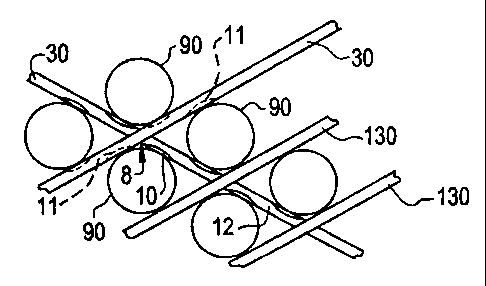Some of the information on this Web page has been provided by external sources. The Government of Canada is not responsible for the accuracy, reliability or currency of the information supplied by external sources. Users wishing to rely upon this information should consult directly with the source of the information. Content provided by external sources is not subject to official languages, privacy and accessibility requirements.
Any discrepancies in the text and image of the Claims and Abstract are due to differing posting times. Text of the Claims and Abstract are posted:
| (12) Patent: | (11) CA 2341292 |
|---|---|
| (54) English Title: | SCALLOPED LATTICE BAR NUCLEAR STEAM GENERATOR TUBE SUPPORTS |
| (54) French Title: | SUPPORTS DE TUBE DE GENERATEUR NUCLEAIRE DE VAPEUR A RESEAU DE BARRES DENTELEES |
| Status: | Expired and beyond the Period of Reversal |
| (51) International Patent Classification (IPC): |
|
|---|---|
| (72) Inventors : |
|
| (73) Owners : |
|
| (71) Applicants : |
|
| (74) Agent: | SMART & BIGGAR LP |
| (74) Associate agent: | |
| (45) Issued: | 2004-09-28 |
| (22) Filed Date: | 2001-03-16 |
| (41) Open to Public Inspection: | 2001-09-21 |
| Examination requested: | 2001-03-16 |
| Availability of licence: | N/A |
| Dedicated to the Public: | N/A |
| (25) Language of filing: | English |
| Patent Cooperation Treaty (PCT): | No |
|---|
| (30) Application Priority Data: | ||||||
|---|---|---|---|---|---|---|
|
A lattice high bar for a nuclear steam generator tube support bar array has scalloped indentations along its length. The scalloped indentations are located at points on the high bar where water tubes will contact the high bar. The indentations extend from one edge of the high bar to about two-thirds of the distance across the bar. When the high bars are used in a lattice bar array, only the unscalloped portion of the high bar contacts an adjacent supported tube, thereby reducing the contact area and the likelihood of corrosion and cracking and also reducing the length over which inspection is impeded. Additionally, the flow path created by opposed but overlapping scallops at the 120° intersections at certain points along the high bars improves the flow sweeping over the surface of the supported tube.
Un réseau de barres hautes pour un ensemble de supports de tubes d'un générateur nucléaire de vapeur a des indentations dentelées sur toute sa longueur. Les indentations dentelées sont situées à des points de la barre haute où les tubes d'eau entrent en contact avec la barre haute. Les indentations dépassent d'un bord de la barre à environ deux tiers de la distance dans la barre. Lorsque les barres hautes sont utilisées dans un réseau de barres, seule la partie non dentelée de la barre haute entre en contact avec un tube pris en charge adjacent, ce qui réduit la surface de contact et la probabilité de corrosion et de fissuration et réduit également la durée d'empêchement de l'inspection. En outre, le circuit d'écoulement créé par des dentelures opposées, mais qui se chevauchent à des intersections à 120.degrés. à certains endroits, le long des barres hautes améliore l'écoulement balayant la surface du tube pris en charge.
Note: Claims are shown in the official language in which they were submitted.
Note: Descriptions are shown in the official language in which they were submitted.

2024-08-01:As part of the Next Generation Patents (NGP) transition, the Canadian Patents Database (CPD) now contains a more detailed Event History, which replicates the Event Log of our new back-office solution.
Please note that "Inactive:" events refers to events no longer in use in our new back-office solution.
For a clearer understanding of the status of the application/patent presented on this page, the site Disclaimer , as well as the definitions for Patent , Event History , Maintenance Fee and Payment History should be consulted.
| Description | Date |
|---|---|
| Time Limit for Reversal Expired | 2018-03-16 |
| Change of Address or Method of Correspondence Request Received | 2018-01-12 |
| Letter Sent | 2017-03-16 |
| Inactive: IPC from MCD | 2006-03-12 |
| Grant by Issuance | 2004-09-28 |
| Inactive: Cover page published | 2004-09-27 |
| Amendment After Allowance Requirements Determined Compliant | 2004-07-26 |
| Letter Sent | 2004-07-26 |
| Inactive: Final fee received | 2004-06-25 |
| Pre-grant | 2004-06-25 |
| Amendment After Allowance (AAA) Received | 2004-06-25 |
| Letter Sent | 2004-02-13 |
| Notice of Allowance is Issued | 2004-02-13 |
| Notice of Allowance is Issued | 2004-02-13 |
| Inactive: Approved for allowance (AFA) | 2004-01-28 |
| Inactive: Cover page published | 2001-09-25 |
| Application Published (Open to Public Inspection) | 2001-09-21 |
| Inactive: First IPC assigned | 2001-06-15 |
| Inactive: Filing certificate - RFE (English) | 2001-04-23 |
| Filing Requirements Determined Compliant | 2001-04-23 |
| Letter Sent | 2001-04-23 |
| Application Received - Regular National | 2001-04-23 |
| Request for Examination Requirements Determined Compliant | 2001-03-16 |
| All Requirements for Examination Determined Compliant | 2001-03-16 |
There is no abandonment history.
The last payment was received on 2004-03-01
Note : If the full payment has not been received on or before the date indicated, a further fee may be required which may be one of the following
Please refer to the CIPO Patent Fees web page to see all current fee amounts.
Note: Records showing the ownership history in alphabetical order.
| Current Owners on Record |
|---|
| BABCOCK & WILCOX CANADA LTD. |
| Past Owners on Record |
|---|
| WILLIAM G. SCHNEIDER |